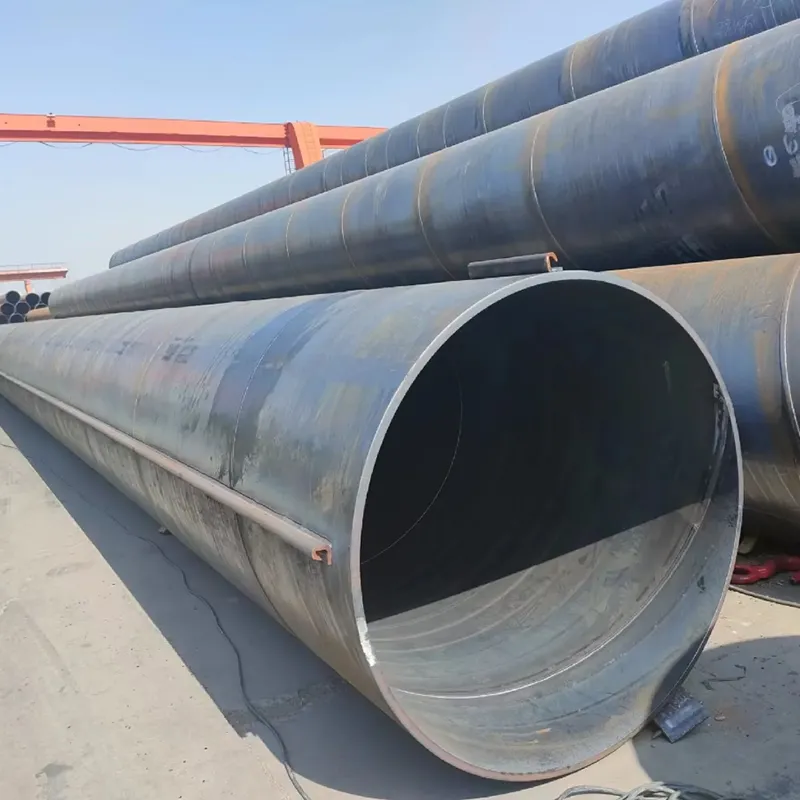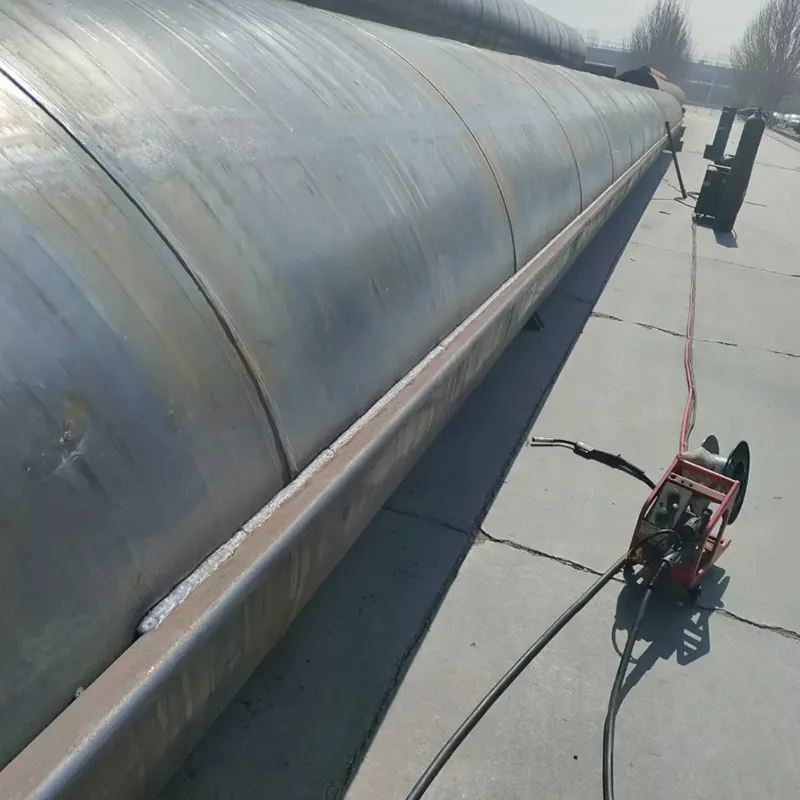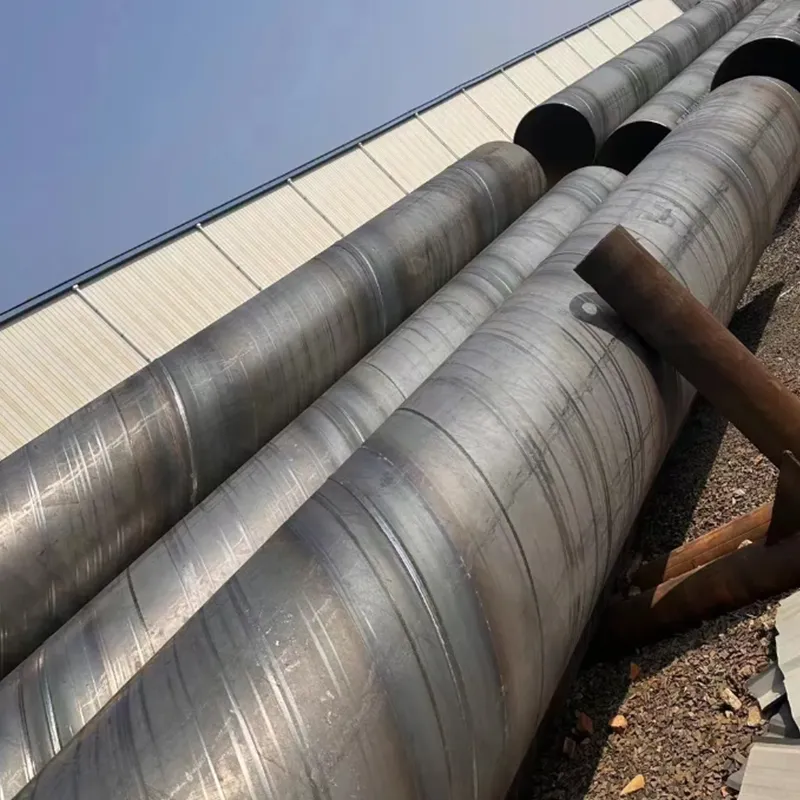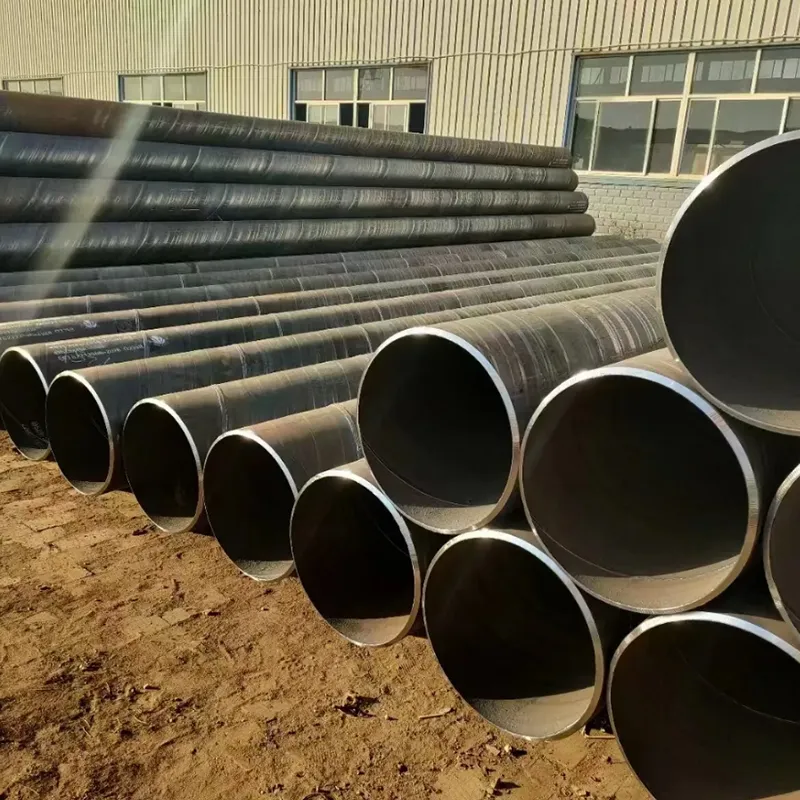The specific production process is as follows:
Raw material preparation: steel coils, welding wires, flux and other raw materials are selected and strictly physical and chemical inspections are carried out.
Strip steel processing: the strip steel is butt-jointed head and tail, and single-wire or double-wire submerged arc welding is adopted. After rolling into steel pipes, automatic submerged arc welding is adopted for repairing. Before forming, the strip steel is leveled, trimmed, planed, surface cleaned, conveyed and pre-bent.
Forming and welding: external or internal control roller forming is adopted, and the weld gap control device is used to ensure that the weld gap meets the welding requirements. The internal and external welding are both carried out by the American Lincoln electric welder for single-wire or double-wire submerged arc welding to ensure the welding quality.
Detection and cutting: the welded welds are inspected by online continuous ultrasonic automatic flaw detector to ensure 100% coverage of spiral weld non-destructive testing. The steel pipe is cut into single pieces by air plasma cutting machine. The first three pieces of each batch of steel pipes are strictly inspected to check the mechanical properties, chemical composition, and fusion status of the welds.
Subsequent processing: Each steel pipe needs to undergo a hydrostatic pressure test and the pipe end must be machined to accurately control the end face verticality, groove angle and blunt edge.
Product Features
High strength: It is stronger than straight seam steel pipes and can withstand greater pressure. It is suitable for occasions where high-pressure fluid is transported.
Good corrosion resistance: It can be used in a variety of environments, especially after anti-corrosion treatment, it can effectively resist external corrosion factors and extend its service life.
Flexible specifications: It has greater flexibility in the size and specification range of diameter and wall thickness, which can meet users' more requirements for spiral steel pipe specifications, especially in the production of high-grade thick-walled pipes, especially small and medium-sized thick-walled pipes.
Continuous production: In theory, a single steel pipe of unlimited length can be produced, which is not limited by equipment and has high production efficiency.
No high requirements on steel plate size: Less steel plate cutting during production, high metal utilization.
Reliable welding quality: The double-sided submerged arc welding process can be used to achieve welding in the best position, and it is not easy to have defects such as misalignment, welding deviation and incomplete penetration, and it is easy to control welding quality.
Strict quality inspection: 100% quality inspection of steel pipes is carried out, so that the entire process of steel pipe production is under effective inspection and monitoring, effectively ensuring product quality.
Materials and standards
ASTM standards
ASTM A252: "Spiral welded and spirally fastened steel pipes", specifies the manufacturing process, size, weight, material and other requirements of spiral welded and spirally fastened steel pipes, and is commonly used in general structural and non-pressure pipeline applications, such as building structure support, drainage pipes, etc.
ASTM A711: "Resistance welded and induction welded spiral steel pipes for pressure use", suitable for resistance welded and induction welded spiral steel pipes for pressure purposes, and makes detailed provisions on the material, mechanical properties, manufacturing process and inspection and test methods of steel pipes, which can be used in pressure pipeline systems such as petroleum, chemical industry, and water transportation.
API standards
API SPEC 5L: "Pipeline Steel Pipe Specification", this standard is applicable to spiral steel pipes for transporting oil and gas in the oil and gas industry, covering the size, steel grade, manufacturing process, inspection and test methods of steel pipes, etc., with two quality grades, PSL1 and PSL2. The technical requirements of PSL2 are more stringent to ensure the reliability and safety of steel pipes in oil and gas transportation.
API SPEC 5CT: Specification for Casing and Tubing, mainly used for spiral steel pipes used in oil and gas wells, has detailed provisions on the size, steel grade, threaded connection and other aspects of the steel pipe to ensure its sealing and reliability in the complex environment of the well and meet the needs of oil and gas extraction.
EN Standard
EN 10219-1: "Cold-formed welded circular steel pipes of non-alloy and fine-grained steel Part 1: Technical delivery conditions", specifies the technical delivery conditions of cold-formed welded circular spiral steel pipes of non-alloy and fine-grained steel, including requirements for size, tolerance, material, mechanical properties, etc., and is commonly used in construction, machinery manufacturing and other fields.
EN 10219-2: "Cold-formed welded circular steel pipes of non-alloy and fine-grained steel Part 2: Tolerances, shape and weight", mainly specifies the specific requirements for tolerances, shape and weight of cold-formed welded circular spiral steel pipes of non-alloy and fine-grained steel, providing clear standards for the production and inspection of steel pipes.
JIS Standard
JIS G3474: "Welded Steel Pipes for General Structures", applicable to spiral welded steel pipes for general structural purposes, specifies the size, shape, weight, material and mechanical properties of steel pipes, and is widely used in building structures, bridges, towers and other fields.
JIS G3484: "Centrifugal Cast Steel Pipes for High Temperature and High Pressure", although mainly for centrifugal cast steel pipes, in some special application scenarios of high temperature and high pressure, spiral steel pipes may also refer to this standard, which has strict regulations on the high temperature performance, chemical composition, mechanical properties, etc. of steel pipes, and is often used in high temperature and high pressure pipeline systems in the power, chemical and other industries.
Uses
Petrochemical industry: widely used in long-distance pipelines for oil and natural gas, as well as various process pipelines in petrochemical plants, for transporting crude oil, natural gas, refined oil, chemical raw materials and products, etc. .
Heat pipe network: used to transport high-temperature, high-pressure hot water, steam and other media, and provide a transportation channel for urban centralized heating systems or heat supply in industrial production .
Urban water supply and drainage engineering: as an important pipe material for urban water supply and drainage pipelines, it is used to transport tap water, sewage, etc. .
Construction field: can be used for supporting structures of buildings, such as building pile foundations, bridge pier foundations, tunnel support structures, etc., and can also be used for load-bearing components of building roofs and suspended structures.
Steel structure manufacturing: as the raw material of steel structure materials, it is made into steel components of various shapes, such as steel beams, steel columns, etc., which are used for the structural frames of large buildings such as industrial plants, gymnasiums, exhibition halls, etc. .
Mining and coal industry: used for connecting pipes for coal mine ventilation equipment and underground water pumps, as well as support and drainage pipes for mine tunnels, etc. .
Marine engineering: It has strong corrosion resistance and is suitable for marine environments, such as offshore oil and gas pipelines, support columns of offshore platforms, and subsea immersed pipes.
Waste disposal and environmental protection industries: It is used as pipelines for landfills and sewage treatment plants, as well as pipelines for waste gas and wastewater treatment in the chemical industry.



















